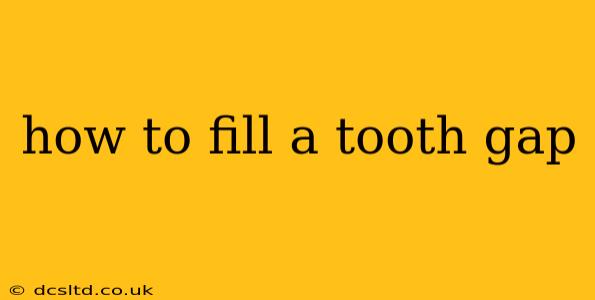A missing tooth can affect your smile, confidence, and even your ability to chew properly. Fortunately, there are several effective ways to fill a tooth gap, each with its own pros and cons. This guide explores the various options available, helping you make an informed decision about the best solution for your individual needs.
What are the different ways to fill a tooth gap?
This is a common question, and the answer depends on several factors, including the location of the gap, the overall health of your mouth, and your budget. Here are some of the most common methods:
-
Dental Implants: Dental implants are considered the gold standard for replacing missing teeth. They involve surgically placing a titanium post into the jawbone, which acts as a root for a replacement tooth (a crown). Implants offer excellent stability, function, and a natural look. They're a long-term solution but require more time and a greater financial investment than other options.
-
Dental Bridges: A dental bridge is a prosthetic that fills the gap by attaching artificial teeth to the adjacent natural teeth. These "anchor" teeth are prepared by being slightly reshaped to support the bridge. Bridges are a more affordable alternative to implants but can put stress on the neighboring teeth.
-
Partial Dentures: Partial dentures are removable appliances that replace one or more missing teeth. They are held in place by clasps that attach to nearby natural teeth. Partial dentures are a more budget-friendly option, but they may not be as comfortable or aesthetically pleasing as implants or bridges.
-
Removable Partial Dentures: These dentures are similar to partial dentures, but they are removable and easier to clean. They can be a good choice for individuals with multiple missing teeth.
-
Flippers (Immediate Dentures): A temporary solution, often used while waiting for a more permanent restoration like an implant or bridge. These are typically made of acrylic and easily removed.
What is the best way to fill a tooth gap?
There's no single "best" way to fill a tooth gap, as the ideal solution depends on your individual circumstances. Your dentist will consider factors such as:
-
The number of missing teeth: A single missing tooth might be easily replaced with an implant or bridge, while multiple missing teeth may necessitate a partial denture.
-
The health of your jawbone: Dental implants require sufficient jawbone density for successful integration. Bone grafting may be necessary in cases of bone loss.
-
Your overall oral health: Good oral hygiene is crucial for the long-term success of any tooth replacement option.
-
Your budget: The cost of different options varies significantly, with implants being the most expensive.
-
Your aesthetic preferences: Some people prefer the natural look and feel of implants, while others find bridges or dentures perfectly acceptable.
What are the costs associated with each method?
The cost of filling a tooth gap varies widely depending on location, the complexity of the procedure, and the type of restoration. It's best to consult with your dentist for a personalized cost estimate. Generally, implants are the most expensive, followed by bridges, and then partial dentures. Flippers are typically the least expensive but are temporary solutions.
How long does it take to get a tooth gap filled?
The timeframe for filling a tooth gap depends on the chosen method and individual circumstances. Implants, for example, often involve multiple appointments over several months, while a bridge can be completed in a shorter timeframe. Your dentist will provide a detailed timeline during your consultation.
How do I care for my new tooth replacement?
Proper oral hygiene is essential for maintaining the health and longevity of any tooth replacement. This includes brushing twice daily, flossing daily, and regular dental checkups and cleanings. Specific care instructions will be provided by your dentist depending on the chosen method. For example, implants may require special cleaning techniques.
By carefully considering your options and consulting with your dentist, you can find the best way to fill your tooth gap and restore your smile and confidence. Remember, proactive care is key to maintaining a healthy and beautiful smile.
